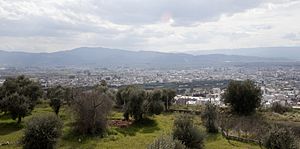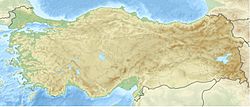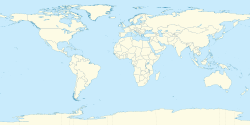Aydın facts for kids
Quick facts for kids
Aydın
|
||
|---|---|---|
|
Metropolitan municipality
|
||

Aydın skyline
|
||
|
||
| Country | ||
| Province | Aydın | |
| Population
(2022)
|
||
| • Total | 259,027 | |
| Time zone | UTC+3 (TRT) | |
Aydın (pronounced EYE-din) is a city in Turkey. It is the main city of Aydın Province in Turkey's Aegean Region. The city is located in the beautiful valley of the Büyük Menderes River. This area has always been known for its rich and fertile land.
Aydın is famous for its figs, which are a very important crop. Many other farm products are also grown here. The city also has some light industries, meaning factories that make smaller goods. Aydın is a busy transport hub. A big motorway connects it to İzmir, a major port city, in less than an hour. It's also close to the Adnan Menderes Airport. The Aydın region was one of the first places in Turkey to have railways in the 1800s. It still has a very dense network of train tracks.
The province of Aydın is home to many famous historical sites and popular tourist spots.
Contents
What Does "Aydın" Mean?
When Turks first took over the city, it was called Güzelhisar. This name means "the beautiful castle". Later, a Turkish group called the Aydinids took control. They named the city after their dynasty.
The word "Aydın" in Turkish means "lucid" or "enlightened". Today, it also means "educated" or "intellectual". It is still a popular name for boys in Turkey.
In ancient Greek times, the city had names like Anthea and Euanthia. During the time of the Seleucid kings, it was called Antiochia. The Romans and Byzantines knew it as Tralles. This was one of the biggest cities in the Aegean region long ago.
Even after the Aydinids, the name Güzelhisar was sometimes used. But over time, Aydın became the preferred name.
Aydın's Long History
Ancient Times
The city of Tralles was founded by people from Argos and Tralles. It became part of the Persian Empire. Later, Alexander the Great took over the city without a fight in 334 BC.
After Alexander, different rulers controlled Tralles. The Seleucids held it until 190 BC, when it became part of Pergamon. The city supported a rebel against the Romans, so the Romans took away its right to make coins.
Tralles was badly damaged by an earthquake in 26 BC. The Roman emperor Augustus helped rebuild it. To thank him, the city renamed itself Caesarea.
Ancient writers described Tralles as a busy trading center. Famous people from Tralles include Anthemius of Tralles, who helped design the famous Hagia Sophia church in Constantinople.
Christianity and Byzantine Era

Christianity came to Tralles early on. A bishop named Polybius lived there around 105 AD. The city became an important center for the church.
After a big battle in 1071, the Seljuks took Tralles. But the Byzantine Empire soon got it back. By the 1200s, the city was mostly in ruins. In 1278, Emperor Andronikos II Palaiologos decided to rebuild it. He wanted it to be a strong point against Turkish attacks.
However, Turkish attacks continued. The city was captured by the Menteshe group in 1284. It was badly damaged, and many people were taken as slaves.
Turkic and Ottoman Times
Under the Menteshe group, the city was called Güzelhisar. Later, the Aydinids took over and made it one of their main cities. The Aydinids were very active in the Aegean Sea in the 1300s.
The rising Ottoman Empire eventually took control of Aydın. This happened first in 1402, then permanently in 1425. Aydın became part of the Ottoman Empire.
In the 1800s, Aydın continued to grow because of its rich valley. Besides figs and olive oil, cotton became very important. Many European investors came to buy cotton, especially during the American Civil War.

Building the İzmir-Aydın Railway
The first railroad in the Ottoman Empire was built by a British company. It connected Aydın to Smyrna (now İzmir). The 130 km (81 mi) line started in 1856 and took ten years to finish. This railway completely changed the economy of the Aydın region. The old train station in Aydın is still an impressive building today.
Greek Occupation and Resistance
During the Greco-Turkish War (1919-1922), there was fierce fighting in Aydın. This happened especially during the Battle of Aydın in 1919. Many people living in the city, both Turkish and Greek, suffered greatly.
Aydın was in ruins until the Turkish army took it back on September 7, 1922. Local resistance fighters, like the efe Yörük Ali, became heroes in Turkey. They fought a guerrilla war against the Greek army from the mountains. After the war, the Greeks living in Aydın moved to Greece. At the same time, Muslims living in Greece moved to Turkey. This was part of a big population exchange in 1923.
Modern Aydın
In recent years, Aydın has grown beyond just farming. It now has a strong economy based on services. A big step was the opening of Adnan Menderes University in 1992. It is named after Adnan Menderes, a former Turkish prime minister from Aydın.
The city's economy is also boosted by its closeness to the coast. Many people from Aydın own summer houses near popular tourist spots like Kuşadası and Didim.
Aydın still feels like a quiet market town. It is very important for producing and trading agricultural products, especially figs. Most of this trade happens right from Aydın.
The city center of Aydın is growing. It has a main street with shops and cafes, and many small side streets with orange trees. People in Aydın are very family-oriented. There isn't much nightlife or many cultural places for young people yet. But with the university, this might change. The city has many mosques, high schools, and other public buildings. Like other Turkish cities, Aydın is expanding as people move to newer homes outside the city center.
Climate
Aydın has a hot summer Mediterranean climate. This means summers are very hot and dry. Temperatures often go above 35.0°C (95.0°F) in summer. Spring and fall are warm. Winters are mild and quite rainy.
- Highest recorded temperature: 45.1°C (113.2°F) on August 3, 2021
- Lowest recorded temperature: -11.0°C (12.2°F) on January 4, 1942
| Climate data for Aydın (1991–2020, extremes 1941–2023) (elevation: 56, coordinates:37°50′25″N 27°50′16″E / 37.84028°N 27.83778°E) | |||||||||||||
|---|---|---|---|---|---|---|---|---|---|---|---|---|---|
| Month | Jan | Feb | Mar | Apr | May | Jun | Jul | Aug | Sep | Oct | Nov | Dec | Year |
| Record high °C (°F) | 23.8 (74.8) |
27.4 (81.3) |
32.4 (90.3) |
35.4 (95.7) |
42.6 (108.7) |
44.4 (111.9) |
44.8 (112.6) |
45.1 (113.2) |
43.3 (109.9) |
39.5 (103.1) |
31.1 (88.0) |
25.9 (78.6) |
45.1 (113.2) |
| Mean daily maximum °C (°F) | 13.5 (56.3) |
15.2 (59.4) |
18.7 (65.7) |
23.2 (73.8) |
28.9 (84.0) |
34.2 (93.6) |
37.0 (98.6) |
36.6 (97.9) |
32.6 (90.7) |
27.0 (80.6) |
20.3 (68.5) |
14.7 (58.5) |
25.2 (77.4) |
| Daily mean °C (°F) | 8.2 (46.8) |
9.5 (49.1) |
12.3 (54.1) |
16.1 (61.0) |
21.2 (70.2) |
26.2 (79.2) |
28.7 (83.7) |
28.3 (82.9) |
24.0 (75.2) |
19.1 (66.4) |
13.5 (56.3) |
9.5 (49.1) |
18.1 (64.6) |
| Mean daily minimum °C (°F) | 4.4 (39.9) |
5.3 (41.5) |
7.2 (45.0) |
10.5 (50.9) |
14.9 (58.8) |
19.1 (66.4) |
21.5 (70.7) |
21.4 (70.5) |
17.6 (63.7) |
13.6 (56.5) |
9.0 (48.2) |
5.9 (42.6) |
12.5 (54.5) |
| Record low °C (°F) | −11.0 (12.2) |
−5.4 (22.3) |
−5.0 (23.0) |
−0.8 (30.6) |
4.6 (40.3) |
8.4 (47.1) |
13.4 (56.1) |
11.8 (53.2) |
7.6 (45.7) |
1.6 (34.9) |
−4.7 (23.5) |
−5.3 (22.5) |
−11.0 (12.2) |
| Average precipitation mm (inches) | 111.3 (4.38) |
87.4 (3.44) |
70.8 (2.79) |
53.4 (2.10) |
43.8 (1.72) |
14.3 (0.56) |
6.0 (0.24) |
6.1 (0.24) |
18.4 (0.72) |
45.2 (1.78) |
86.5 (3.41) |
110.3 (4.34) |
653.5 (25.73) |
| Average precipitation days | 11.13 | 10.53 | 9.53 | 8.80 | 7.33 | 2.90 | 0.70 | 0.77 | 2.57 | 5.90 | 7.93 | 11.97 | 80.1 |
| Average snowy days | 0.33 | 0.17 | 0 | 0 | 0 | 0 | 0 | 0 | 0 | 0 | 0 | 0.04 | 0.54 |
| Average relative humidity (%) | 72.5 | 69.5 | 65.5 | 62.4 | 57.5 | 49.8 | 48.4 | 52.2 | 56 | 63.2 | 69.2 | 74.3 | 61.7 |
| Mean monthly sunshine hours | 111.6 | 113.0 | 161.2 | 183.0 | 229.4 | 264.0 | 291.4 | 272.8 | 231.0 | 179.8 | 126.0 | 99.2 | 2,262.4 |
| Mean daily sunshine hours | 3.6 | 4.0 | 5.2 | 6.1 | 7.4 | 8.8 | 9.4 | 8.8 | 7.7 | 5.8 | 4.2 | 3.2 | 6.2 |
| Source 1: Turkish State Meteorological Service | |||||||||||||
| Source 2: NOAA NCEI(humidity), Ogimet, Meteomanz(snow days 2000-2023) | |||||||||||||
Economy in Aydın
In the 1920s, Aydın was known for its cotton and grain. Today, there are many olive trees in Aydın. Some people make olive oil at home. There are also many small companies that send olive oil to other countries.
Getting Around Aydın
A modern six-lane motorway connects Aydın to İzmir. This makes the trip less than an hour. It's even faster to get to the international Adnan Menderes Airport.
Culture and Fun in Aydın
Music
A famous ancient musical piece, the Seikilos epitaph, was found near Aydın.
Sports
Aydın has several sports teams. The Aydın Büyükşehir Belediyespor Women's Volleyball team is very successful. They even played in the final of a European cup, the Challenge Cup, and came in second. In football, Nazilli Belediyespor is a local team. Aydın PTT SK plays in the Handball Men's 1st League.
Places to Visit
- The old Ottoman mosques: Ramazan Paşa, Süleyman Paşa, and Cihanoğlu.
- The Byzantine tower and old walls above the town.
- Roman ruins of Tralles, including a gymnasium and a theater.
- The statue of Yörük Ali Efe in the town.
- Aydın Archaeological Museum - here you can see ancient items, coins, and things from local culture.
- Recreational parks Pınarbaşı and Aytepe, connected by a gondola.
- Altinkum Plaji, Didim Aydın. This is a large beach area with interesting features.
Famous People from Aydın
- Anthemius of Tralles (around 474-534 AD) - A Greek geometry professor and architect. He helped build the famous Haghia Sophia church.
- Alexander of Tralles (6th century) - A well-known doctor.
- Atçalı Kel Mehmet Efe (1780–1830) - A local leader who led a revolt against the Ottoman government.
- Yörük Ali Efe (1895 - 1951) - A military leader and hero during the Turkish War of Independence.
- Adnan Menderes (1899–1961) - He was a Prime Minister of Turkey in the 1950s.
- Gökhan Kırdar (born 1970) - A musician and composer of film music.
Sister Cities
Aydın has "sister city" relationships with:
|
See also
 In Spanish: Aydın para niños
In Spanish: Aydın para niños















